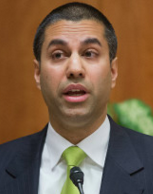A federal appeals court dismissed a challenge to the FCC’s continued use of a rule that allows broadcasters to get a break for their UHF holdings.
According to Variety, the so-called “UHF discount” allows media companies to count their UHF stations at half their reach, which has allowed many station groups to amass more outlets and still fall within limits to broadcast ownership.
The appeals court said that the plaintiffs in the case, including the public interest group Free Press, lacked standing, but said that they did not consider the merits of the case.
 |
| Ajit Pai |
The discount was put in place in the 1980s as a way to give stations a break given that the UHF signal was typically a poorer quality with a shorter reach. But those differences disappeared with the transition to digital television, and in 2016, the FCC voted to abolish it.
That changed when Pai became chairman and Republicans took the majority on the commission. They voted to restore the discount in April, 2017, arguing that it such a move had to be considered in conjunction with looking at other media ownership limits.
At a D.C. Circuit hearing in the spring, a three-judge panel appeared to question why an obsolete rule was still on the books. But they also raised some questions about the standing of public interest advocates who brought the case.

No comments:
Post a Comment
Note: Only a member of this blog may post a comment.